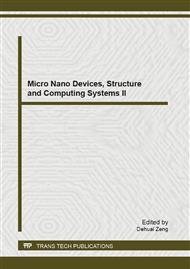[1]
National Institute of Standards and Technology (U. S). Advanced Encryption Standard available at http: /csrc. nist. gov/publications/fips/fips197/fips-197. pdf, (2001).
Google Scholar
[2]
Solmaz Ghaznavi, Catherine Gebotys and Reouven Elbaz, Efficient technique for the FPGA implementation of the AES Mix columns Transformation, International conference on Reconfigurable Computing and FPGAs, pp.219-224, (2009).
DOI: 10.1109/reconfig.2009.52
Google Scholar
[3]
Viktor Fischer, Milos Drutarovsky, Pawel Chodowiec, InvMixcolumn Decomposition and Multilevel Resource Sharing in AES Implementation, in IEEE Trans. On VLSI systems, no. 8, vol. 13, pp.989-992 August, (2005).
DOI: 10.1109/tvlsi.2005.853606
Google Scholar
[4]
Nalini C. Iyer, Deepa, Anandmohan P. V, Poornaiah D.V., Mix/InvMixColumn Decomposition and Resource sharing in AES, 2010 5th International Conference on Industrial and Information Systems, ICIIS 2010, Jul 29 - Aug 01, 2010, India.
DOI: 10.1109/iciinfs.2010.5578713
Google Scholar
[5]
Nalini C. Iyer, Anandmohan P. V, Poornaiah D.V.,V.D. kulkarni, Compact Designs of SubBytes and MixColumn for AES, 2009 WEE International Advance Conputing Conference (IACC 2009) Patialae, India, 6-7 Ma-crch (2009).
DOI: 10.1109/iadcc.2009.4809193
Google Scholar
[6]
A. Amaar, I. Ashour, M. Shiple, Design and Implementation a Compact AES Architecture for FPGA Technology, World Academy of science , Engineering and Technology 59 (2011).
Google Scholar
[7]
Power Methodology Guide http: /www. xilinx. com/support/documentation/sw_manuals/xilinx13_1/ug786_PowerMethodology. pdf.
Google Scholar
[8]
Reducing Switching Power with Intelligent Clock Gating http: /www. xilinx. com/support/documentation/white_papers/wp370_Intelligent_Clock_Gating. pdf.
Google Scholar
[9]
ISE 10. 1 software http: /www. xilinx. com/support/download/index. htm.
Google Scholar
[10]
xilinx power analyzer documentation http: /www. xilinx. com/products/design_tools/logic_design/verification/xpower_an. htm.
Google Scholar
[11]
Xilinx power Estimator user guide http: /www. xilinx. com/support/documentation/user_guides/ug440. pdf.
Google Scholar


